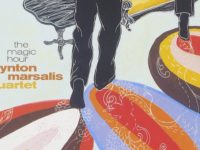Funky and tough, the Jazz Messengers were, until the very end, a group best heard blasting away on stage as vital, hard bop pioneers. That made this the definitive late-period release from Art Blakey.
“Art Collection” features two celebrated tracks with Wynton and Branford Marsalis, as well as one with Bobby Watson and Wynton Marsalis, and another with long-tenured tenor David Schnitter.
But I’ve always been more intrigued by the cuts with trumpeter Terence Blanchard and saxophonist Donald Harrison. Included are three recorded in 1984 and ’85 — notably “Second Thoughts,” which absolutely cooks.
They auditioned after the Marsalises left Blakey’s band — appropriately enough, as the story goes, at a place called Fat Tuesday’s — in 1982. Blanchard was playing in Lionel Hampton’s Band, he told me, while Harrison was with Roy Haynes.
“It was overwhelming,” Blanchard said. “It was a hell of a time in my life.”
Even then a hot-playing young prospect, Blanchard nevertheless tried to stay in his rightful place.
After all, prior to his untimely death in 1990, Blakey had played alongside Them All: Jackie McLean and Lee Morgan, Hank Mobley and Johnny Griffin, Benny Golson and Curtis Fuller, Sonny Stitt and Julian “Cannonball” Adderley (with whom Blanchard shares a passing resemblence), Wayne Shorter and Clifford Brown, Donald Byrd and Cedar Walton, Woody Shaw and on and on.
But Blakey kept his gaze fixed on the future, telling Blanchard: “I don’t want you to give a sh-t about Freddie Hubbard, Woody Shaw, Miles Davis, Dizzy Gillespie, none of them. I just want you to be in this band and work hard at being the best you can be.”
In fact, Blakey’s group was bested only by Davis’ in producing successive generations of important jazz musicians.
Blanchard listened carefully, and quickly blossomed. Later, he moved away from the static traditionalism of fellow New Orleans native Wynton Marsalis into something his former mentor Blakey would have richly appreciated: African fusion.
“There’s a tendency to think that, you know, Bird is Bird, and I could never be Bird,” Blanchard said in a phone interview. “Which is true, you can never be Bird. But you can be yourself.”
The heart of Blakey’s message had been simple: “We could be jazz musicians ourselves,” Blanchard remembered, “if we worked hard.”
And work hard they did. This version of the Jazz Messengers toured incessantly during Blanchard’s five-year stint, only stopping long enough to record two studio albums. (“New York Scene,” from 1983, won a Grammy.)
The band learned to play with one eye on Blakey, who might shift tempos and arrangements like a summer storm rolling in. Soon they were so tight, and the history inside Blakey’s songbook so long, that Blanchard and the other Messengers once played an entire week in Minneapolis, appearing on two shows a night, and never repeated a song until the last show, Blanchard said.
That made these unearthed live records all the more memorable in 1992.
Even late in Blakey’s life, no drummer drove a band harder — as a leader and as an instrumentalist. Contemporaries like Max Roach (who would later tour all by himself) dealt with more delicate concerns like timbre and melody. Some jazz guys even used brushes. Not Blakey, who was about two things: Rhythm, and how.
He moved with power and grace through these sides — leaving the flourishes to bandmates like Blanchard, who was already inhabiting moments of embryonic brilliance as a soloist.
Blanchard, of course, left not long afterward. That happened with a metronomic frequency for Blakey, the downside of running one of jazz music’s most proficient protege factories.
Blanchard and Harrison had already released two of their own recordings while still touring with the Jazz Messengers, and that made their ultimate departure in 1986 a bit easier.
“Art knew that his mission,” Blanchard told me, “was to turn out young jazz musicians to be band leaders.”
After a stint with Harrison and some time to rework his playing style, Blanchard would ultimately fulfill that promise.
“Terence Blanchard” and then “Simply Stated,” solo records from 1992-93, both would reach the Top 10 on Billboard’s traditional jazz charts. He’s since established a long association with filmmaker Spike Lee and now serves as artistic director for the Thelonious Monk Institute of Jazz Performance.
- How Deep Cuts on ‘Music From Big Pink’ Underscore the Band’s Triumph - July 31, 2023
- How ‘Islands’ Signaled the Sad End of the Band’s Five-Man Edition - March 15, 2022
- The Band’s ‘Christmas Must Be Tonight’ Remains an Unjustly Overlooked Holiday Classic - December 25, 2016



